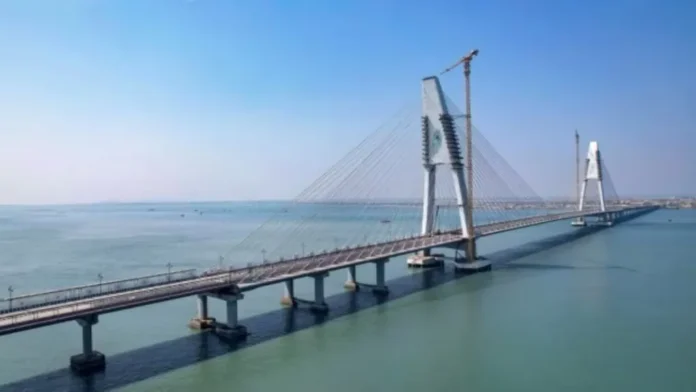When the Arabian Sea shimmers under the Gujarat sun, a slender ribbon of steel and concrete now glides across its surface — a bridge that is both a feat of faith and a marvel of engineering. Sudarshan Setu, the 2.32 kilometre cable-stayed bridge connecting Okha to Beyt Dwarka, has swiftly become one of India’s most iconic infrastructure landmarks since its inauguration in February 2024.
The story behind the bridge
For decades, reaching Beyt Dwarka — an island revered for its ancient temples — meant waiting for ferries that battled tides and time. The Gujarat State Road Development Corporation (GSRDC), backed by the Ministry of Road Transport and Highways, envisioned a permanent steel reinforced link to ease pilgrim movement and boost regional connectivity.
Construction began in 2017, with an ambitious design brief: to create a bridge that could withstand the coastal winds and saline air while offering a visual identity befitting its spiritual surroundings. After years of precision engineering, supply chain coordination, and pandemic era disruptions, the structure was finally completed in December 2023 and opened to the public by Prime Minister Narendra Modi on 25 February 2024.
Design and structural brilliance
Sudarshan Setu is not just another bridge; it is a steel intensive cable-stayed structure that pushes the boundaries of long span design. The bridge stretches 2,320 metres, supported by 152 metres high pylons anchored with high tension steel cables designed to bear intense wind loads of up to 200 kilometres per hour.
Each of the 32 main spans is composed of steel box girders fabricated off site and launched using incremental cantilevering — a method chosen to reduce work over the open sea. These girders, formed from weather resistant structural steel, were pretreated with epoxy polyurethane coatings to ensure corrosion protection against the saline atmosphere.
According to data from GSRDC and project engineers, the bridge used approximately 24,000 tonnes of structural and reinforcement steel, including high tensile grades for pylons and stay cable anchorages.
A continuous dual carriageway rests upon orthotropic steel decks, ensuring lightweight performance while providing exceptional rigidity. The decks are supported by stay cables made from parallel wire strands of galvanised high strength steel, each strand tensioned to withstand more than 250 tonnes of axial load.
Beyond the numbers, the bridge is a sculpture in steel — its pylons inspired by the Sudarshan Chakra, Lord Krishna’s celestial discus, symbolising protection and balance.
Performance meets passenger experience
For passengers, the experience of crossing Sudarshan Setu feels less like a commute and more like a journey through the horizon. The unobstructed 360-degree view of the sea — made possible by slender steel guardrails and wide-open spans — turns a 30-minute ferry ride into a serene 10-minute drive.
LED lighting integrated into the stay cables gives the structure a floating silhouette at night. The steel pylons, shimmering with programmable light patterns, transform the bridge into a living monument — part utility, part cultural beacon.
The deck’s steel composition also plays a subtle role in comfort: the orthotropic panels limit vibrations, ensuring stability even under high-speed vehicular loads. Combined with corrosion proof fixtures and bearings, the bridge promises a design life of over 100 years with minimal maintenance.
Why Sudarshan Setu matters for India’s steel narrative
Sudarshan Setu’s completion in 2024 underscores a crucial message for India’s steel sector: the future lies not just in volume but in value — in long span, high performance steel structures that demand innovation over repetition.
From the heavy plate fabrication yards in Gujarat and Maharashtra to the precision cable works produced by domestic manufacturers, the project epitomises the Make in India engineering ethos. It also demonstrates that Indian steelmakers and fabricators are ready to take on world class infrastructure challenges requiring metallurgical sophistication, quality assurance, and sustainable design.
Industry experts note that long span projects like Sudarshan Setu represent the next frontier for steel consumption — where demand is tied to precision and longevity, not merely tonnage.
Expert takeaway
Dr Amit Vyas, structural engineer and consultant for multiple cable stayed projects, notes:
“Steel is no longer a hidden skeleton; it is the expressive framework of modern India’s infrastructure. Sudarshan Setu proves how architecture, engineering, and symbolism can coexist when steel is used intelligently.”
The bridge also supports India’s environmental goals — its fully recyclable steel structure minimises lifecycle emissions, and the fabrication avoids excessive concrete use over marine ecosystems.
Closing note
Sudarshan Setu stands as a testament to what happens when design ambition meets metallurgical mastery — a bridge that unites tradition and technology across the tides. As India accelerates its coastal and inland connectivity drives, steel’s versatility will continue to shine through such landmarks.
Next week, our Infrastructure Deep Dive travels eastward to explore the emerging steel superstructures of India’s modern port terminals — where logistics, longevity, and lightweight design converge. Stay tuned as we continue mapping the future, one steel span at a time.




